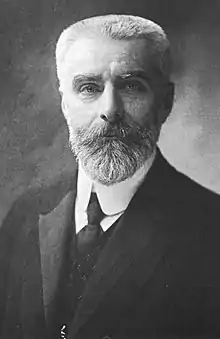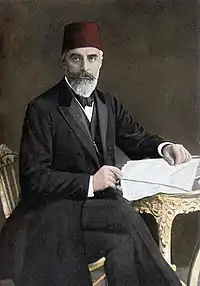Ahmet Rıza
Ahmet Rıza Bey (1858 – 26 February 1930) was an Ottoman-born Turkish politician, educator, and a prominent member of the Young Turks, during the Second Constitutional Era of the Ottoman Empire.[1] He was also a founding member of the Party of Union and Progress.[2] He represented the intellectually strong wing of the party, the opposite of the nationalist wing.[3]
Ahmet Rıza | |
|---|---|
 | |
| Personal details | |
| Born | 1858 Constantinople, Ottoman Empire |
| Died | 26 February 1930 Istanbul, Turkey |
| Occupation | Politician and educator. |
In 1908 he became the first President of the revived Chamber of Deputies, the lower house of the Ottoman Parliament, and in 1912, he was appointed as the President of the Senate (the upper house) as well.[4] He also served as the Minister of Education. In 1908, his name was among the candidates' list for the next Grand Vizier. He was the leading negotiator during the failed agreement of coalition between the Ottoman Empire, France, and Britain for World War I.
Ahmet Rıza has been described as a polymath by some authors.[5]
Biography
Ahmet Rıza was born in Istanbul in 1858, the son of Ali Rıza Bey. His father was nicknamed İngiliz ("Englishman") because of his command of the English language and admiration of the British Empire. His mother, Fraulein Turban, was born in Munich but was of Hungarian origin. She moved to Vienna, where she met İngiliz, and converted to Islam to marry him, taking the name Naile Sabıka Hanım.[6] He graduated from Galatasaray High School in Istanbul and subsequently studied agriculture in France. As a young man, he sought to improve the condition of the peasantry in the Empire. He was concerned with the conditions of the farmers and wanted to implement agricultural methods, supporting the ideas of the French sociologist, Auguste Comte. In 1894, he published a series of publications on unification of Islamic and Ottoman traditions of consultation. In 1895, Meşveret, the journal that he published, became a locus of the exiled Young Turks movement. Ahmet Rıza opposed the maverick Prince Sabahaddin's calls for revolution and European intervention in the empire at the 1902 Congress of Ottoman Opposition in Paris. At the Second Congress of Ottoman Opposition in 1907, Ahmet Rıza at first reluctantly endorsed the use of violence to depose the sultan, but later reversed his position.[7]
 |
 |
 |
(in his early days) |
(in his middle age) |
(in his later years) |
Going to Paris

According to a customized book in 1889, on the pretext of participating in the exhibition organized for the centenary of the French Revolution, there was a customized letter, which indicated he escaped to Paris and did not return. He became an interpreter as he learned French. At the University of Paris, he continued his lectures on positivism, taught by mathematician Pierre Laffitte, as he was influenced by Laffitte's thoughts about Islam and Eastern civilization in particular.[8] Laffitte believed that Islam was the most advanced religion, so it was easy for Muslims to pass through positivism. Ahmet Rıza became one of the most active members of the Société Positiviste (Positivist Society), and since 1905 he has appeared as a "representative of Muslim communities" in the Comité Positif Occidental, establishing the spread of positivist international platitudes.
During his first years in Paris, he attempted to respond to various newspapers and magazines, which were writing unfavourably about the Ottoman Empire. In 1891, he wrote a letter to the postal and telegraph chronicle in Istanbul as he did not obey the instructions of the center of Paris to return to his country due to his use of the expression "liberty" in a lecture on Ottoman women and stated that he did not belong to any secret cemetery. Ahmet Rıza sent his thoughts to Sultan Abdul Hamid II in 1893. He continued to send sheets upon the request of his encouraging response and continuation; he tried to convince him that the constitutional regime was not a bad thing. In the case of sending the sixth party, he began to write political writings in French, which was published by the former Syrian deputy Halil Ganem.
Later career
As an educator, he enacted the inauguration of the second high school for girls in Turkey, the Kandilli High School for Girls in 1916 in Istanbul (it was intended to be the first, but the outbreak of World War I delayed the execution of the project).[9]
After retiring from public life at the end of World War I, Ahmet Rıza wrote his memoirs. They were published more than 50 years after his death in 1988 under the title Meclis-i Mebusan ve Ayan Reisi Ahmet Rıza Bey’in Anıları ("The Memoirs of Ahmet Rıza, the President of the Chamber of Deputies and the Senate"). He died on 26 February 1930 in Istanbul.
He was awarded Order of Karađorđe's Star.[10]
See also
References
- https://www.biyografya.com/biyografi/341
- https://dergipark.org.tr/tr/download/article-file/616940
- https://www.dailysabah.com/portrait/2019/09/06/ahmet-riza-founder-of-young-turk-intellectual-tradition/amp
- 1908 Devrimi Aykut Kansu İletişim Yayınları, ISBN 9789754705096, 2009
- Finkel, Caroline (2006). Osman's dream: the story of the Ottoman Empire, 1300-1923. Basic Books. p. 505. ISBN 0-465-02396-7. Retrieved 2010-06-07.
- Taglia, Stefano (2015). Intellectuals and Reform in the Ottoman Empire: The Young Turks on the Challenges of Modernity. Routledge. p. 52. ISBN 9781317578635. Retrieved 8 August 2017.
- Karal, Enver Ziya (1962). Osmanlı Tarihi Vol. 8. Ankara. p. 517.
- Özdalga, Elisabeth (2005). Late Ottoman Society: The Intellectual Legacy. Psychology Press. ISBN 9780415341646.
- "Tarihce". Archived from the original on 2012-11-28. Retrieved 2012-11-08.
- Acović, Dragomir (2012). Slava i čast: Odlikovanja među Srbima, Srbi među odlikovanjima. Belgrade: Službeni Glasnik. p. 369.